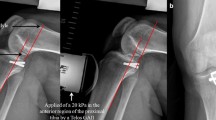Summary
A clinical classification and treatment programme has been developed for chronic medial tibial stress syndrome. Medial tibial stress syndrome has been reported to be either tibial stress fracture or microfracture, tibial periostitis, or distal deep posterior chronic compartment syndrome. Three chronic types exist and may coexist: Type I (tibial microfracture, bone stress reaction or cortical fracture); type II (periostalgia from chronic avulsion of the periosteum at the periosteal-fascial junction); and type III (chronic compartment syndrome). Type I disease is treated nonoperatively. Operations for resistant types II and III medial tibial stress syndrome were performed in 41 patients. Bilaterality was common (type II, 50% type III, 88%). Seven had coexistent type II/III; one had type I/II. Preoperative symptoms averaged 24 months in type II, 6 months in type III, and 33 months in types II/III. Mean age was 22 years (15 to 51). Resting compartment pressures were normal in type II (mean 12mm Hg) and elevated in type III and type II/III (mean 23mm Hg). Type II and type II/III patients received fasciotomy plus periosteal cauterisation. Type III patients had fasciotomy only. All procedures were performed on an out-patient basis using local anaesthesia. Follow up was complete and averaged 6 months (2 to 14 months). Improved performance was as follows: type II, 93%, type III, 100%; type II/III, 86%. Complete cures were as follows: type II, 78%; type III, 75%; and type II/III, 57%. This experience suggests that with precise diagnosis and treatment involving minimal risk and cost the athlete has a reasonable chance of return to full activity.
Similar content being viewed by others
References
Andrish JT, Derfeld JA, Walheim J. A prospective study of the management of shin splints. Journal of Bone and Joint Surgery 1974, 56A: 1697–1700, 1974
Bates P. Shin splints — a literature review. British Journal of Sports Medicine 19: 132–137, 1985
Byrk E, Grantham SA. Shin splints: A chronic deep posterior ischemic compartmental syndrome of the leg? Orthopaedic Reviews 12: 29–40, 1983
Clement DB. Tibial stress syndrome in athletes. Journal of Sports Medicine 2: 81–85, 1974
Davey, JR, Rorabeck, CH, Fowler, PJ. The tibialis posterior muscle compartment. American Journal of Sports Medicine, 12: 391–397, 1984
Detmer DE, Sharpe K, Sufit RL, Girdley FM. Chronic compartment syndrome: diagnosis, management, and outcomes. American Journal of Sports Medicine 13: 162–170, 1985
Devas MB. Stress fractures of the tibia or ‘shin soreness.’ Journal of Bone and Joint Surgery, 40B: 227–239, 1958
Logan JG, Rorabeck CH, Castle GSP. The measurement of dynamic compartment pressure during exercise. American Journal of Sports Medicine, 1: 220–223, 1983
Mubarak SJ. External compartment syndromes. In D’Ambrosia & Drez (eds). Prevention and treatment of running injuries, pp. 1–5. C. B. Slack, Thorofare, 1982
Mubarak SJ, Gould RN, Lee YF, Schmidt DA, et al. The medial tibial stress syndrome. American Journal of Sports Medicine 10: 201–205, 1982
Mubarak SJ, Hargens AR, Owen CA, et al. The wick catheter technique for measurement of intramuscular pressure. Journal of Bone and Joint Surgery 58A: 1016–1020, 1976
Orava S. Exertion injuries due to sports and physical exercise: a clinical and statistical study of nontraumatic overuse injuries of the musculoskeletal system of athletes and keep-fit athletes. Thesis, Turku, Finland, 1980
Puranen J. The medial tibial syndrome. Exercise ischemia in the medial fascial compartment of the leg. Journal of Bone and Joint Surgery, 56B: 712–715, 1974
Rasmussen, W. Shin splints: definition and treatment. Journal of Sports Medicine 2: 111–117, 1974
Rorabeck CH, Bourne RB, Fowler PJ. The surgical treatment of external compartment syndrome in athletes. Journal of Bone and Joint Surgery 65A: 1245–1251, 1983
Scheuch Jr PA. Tibialis posterior shin splint: diagnosis and treatment. Athletic Training Winter 271-274, 1984
Slonin AE, Goans PJ. Myopathy in McArdle’s syndrome. New England Journal of Medicine 312: 355–359, 1985
Stanitski CL, McMaster JH, Scranton PE. On the nature of stress fractures. American Journal of Sports Medicine 6: 391–396, 1978
Wallensten R, Eriksson E. Is medial lower leg pain (shin splint) a chronic compartment syndrome? In Mack RP (Ed) Symposium on the Foot and Leg in Running Sports, pp 135–140, C.V. Mosby, St Louis, 1982
Walter NE, Wolf MD. Stress fractures in young athletes. American Journal of Sports Medicine, 5: 165–170, 1977
Whitesides, TE, Harvey, TC, Harada, H, et al. A simple method for tissue pressure determination. Archives of Surgery 110: 1311–1313, 1975
Author information
Authors and Affiliations
Rights and permissions
About this article
Cite this article
Detmer, D.E. Chronic Shin Splints. Sports Medicine 3, 436–446 (1986). https://doi.org/10.2165/00007256-198603060-00005
Published:
Issue Date:
DOI: https://doi.org/10.2165/00007256-198603060-00005




